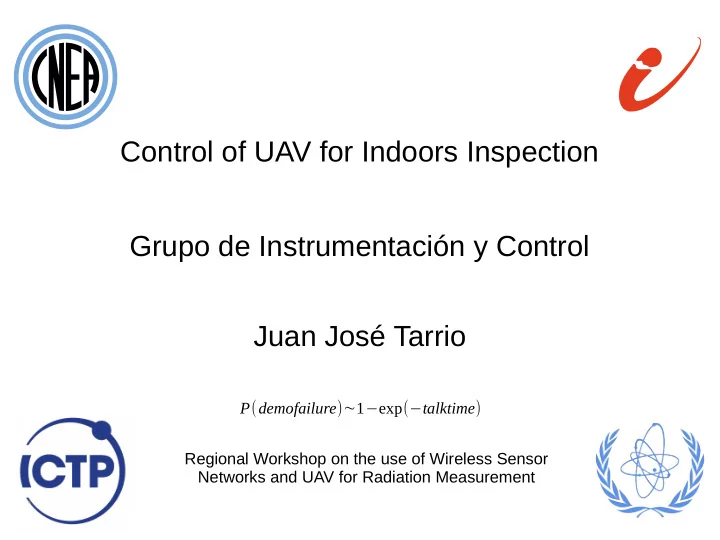

Control of UAV for Indoors Inspection Grupo de Instrumentación y Control Juan José Tarrio P ( demofailure )∼ 1 − exp (− talktime ) Regional Workshop on the use of Wireless Sensor Networks and UAV for Radiation Measurement
A little bit of personal history... Fukushima Student looking for a + (2011) masters thesis UAV for radiation inspection Complex problem, can be tackled at different levels … Started at the low level Not much info in Argentina at the time to get the KNOW HOW
Low level means... build from scratch :) ● Indoors trials evolve into indoors flying Not the same to drop electronics from 1m than from 50m (It will happen if your playing with the control laws all the time)
Indoors flying is challenging! Not harder than outdoors, just different... ● No wind ● Low distances PERCEPTION ● Objects! Complex! You split it... ● Precision + Know were you are + Know what is there + Understanding
Perception sensors for indoors ● GPS Doesn't work indoors ● Radio, WSN Doesn't give structure ● LIDAR Expensive! ● RGBD Fails on outdoors ● VISION Computationally expensive + Monocular + Stereo
State of The Art Monocular Visual Slam Systems ● ORB-SLAM - Sparse Feature Based Raúl Mur-Artal, J. M. M. Montiel and Juan D. Tardós. ORB-SLAM: A Versatile and Accurate Monocular SLAM System. IEEE Transactions on Robotics, vol. 31, no. 5, pp. 1147-1163, 2015 ● DTAM – Dense, Direct Newcombe, R. A., Lovegrove, S. J., & Davison, A. J. (2011, November). DTAM: Dense tracking and mapping in real-time. In Computer Vision (ICCV), 2011 IEEE International Conference on (pp. 2320-2327). IEEE. ● LSD-SLAM – Semidense, Direct Engel, J., Schöps, T., & Cremers, D. (2014). LSD-SLAM: Large-scale direct monocular SLAM. In Computer Vision–ECCV 2014 (pp. 834-849). Springer International Publishing. ● SVO – Mixed Forster, C., Pizzoli, M., & Scaramuzza, D. (2014, May). SVO: Fast semi-direct monocular visual odometry. In Robotics and Automation (ICRA), 2014 IEEE International Conference on (pp. 15-22). IEEE.
And from the south of South America... Realtime Edge Based Visual Odometry for a Monocular Camera (REBVO) ● Fast and “easy” to find. WHY ● Still features, but provide semidense EDGES? information, that could be used to OA ● Can be tracked and mapped very efficiently Juan Jose Tarrio, Sol Pedre; The IEEE International Conference on Computer Vision (ICCV), 2015, pp. 702-710 On GITHUB soon! RUNS 25FPS on ARM! Not a SLAM system... yet
What REBVO does is... ● Detects edges in the image. The set of edge belonging points is called and EdgeMap. ● Tracks Translation and Rotation by “fitting” the previous EdgeMap into the new one. ● Uses the motion to improve the depth measures in an EKF stile scheme.
Mixing with an IMU ● Gyroscope provides rotation. Initialization not an issue. ● Accelerometer provides linear acceleration. Can be used to estimate scale.
Communication Challenge : use the 128KBit radio to tele-operate. Idea : compress edge data and send only the edgemap. Only 2 frames per seconds on low bandwidth radio. Idea 2 : Transmit edgemap at 1HZ and navigation data at frame-rate (25HZ). Use this information to “predict” edges movement.
So finally... the UAV! Designed to use a minimal set of sensors: only camera, gyroscope and accelerometer for control.
Recommend
More recommend